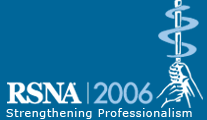
Abstract Archives of the RSNA, 2006
Gregory V. Goldmakher MD, PhD, Abstract Co-Author: Nothing to Disclose
Neel Madan MD, Presenter: Nothing to Disclose
Shahmir Kamalian MD, Abstract Co-Author: Nothing to Disclose
Pamela Whitney Schaefer MD, Abstract Co-Author: Nothing to Disclose
Ramon G Gonzalez, Abstract Co-Author: Nothing to Disclose
Michael Howard Lev MD, Abstract Co-Author: Speaker, General Electric Company
Advisory Board, General Electric Company
Speaker, Bracco Group
Advisory Board, Bracco Group
Advisory Board, CoAxia, Inc
Purpose: CT perfusion (CTP) imaging is an important tool in acute stroke evaluation, but is limited in its ability to obtain sufficient coverage of the brain for a given contrast bolus. A novel CTP acquisition technique, axial “shuttle mode” – in which the CT table “toggles” between two different levels during cine acquisition - could increase coverage and decrease both contrast and radiation dose, but at lower temporal resolution. We simulated axial shuttle mode scanning by undersampling existing CTP data sets, to determine if lower temporal resolution produces diagnostically adequate CTP maps.
Methods: CTP cine images were acquired in 20 patients with MCA stroke at 1 image per second, with contrast injection at 7cc/sec. Source data were undersampled by selecting every third image. CTP maps were created from both the complete and undersampled image sets. Regions of interest (ROIs) were placed in the thalamus and corona radiata on the normal side for signal to noise (SNR) calculation. A reader, blinded to sampling rate, manually segmented the perfusion abnormality on the cerebral blood volume (CBV), flow (CBF) and mean transit time (MTT) maps.
Results: SNR mean values, from complete and undersampled data respectively, were as follows: CBV 2.06 vs. 1.12, p = 0.0057; CBF 1.64 vs. 1.26, p = 0.0010; MTT 0.32 vs. 0.11, p = 0.0114. Decreased SNR in undersampled data was uniformly attributable to increased noise (p<0.05). Despite this, there was no statistically significant difference in CTP lesion size between maps created from the complete and undersampled data sets, with excellent correlation for each map type (CBV R^2=0.929, slope=1.04; CBF R^2=0.912, slope=0.980; MTT R^2=0.962, slope=1.03).
Conclusion: Although CTP maps constructed from cine images acquired every 3 seconds have decreased SNR (due to increased noise) compared to those acquired every second, this does not impair visual assessment of CTP lesion size. Hence, axial shuttle mode acquisition holds promise in doubling the volume of brain parenchyma covered for a given contrast bolus, while reducing total scan time, radiation dose, and contrast dose.Disclosure: See attached
Goldmakher, G,
Madan, N,
Kamalian, S,
Schaefer, P,
Gonzalez, R,
Lev, M,
Hot Topic: Axial "Shuttle Mode" CT Perfusion Acquisition Increases Coverage and Decreases Radiation and Contrast Dose Without Loss of Visual Diagnostic Accuracy. Radiological Society of North America 2006 Scientific Assembly and Annual Meeting, November 26 - December 1, 2006 ,Chicago IL.
http://archive.rsna.org/2006/8002501.html

